A Royal Veterinary College study
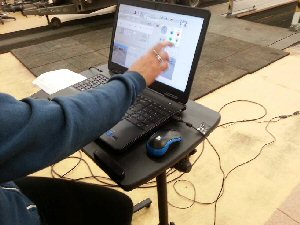 The
question of the introduction of a
4th 550mm hurdle height in Kennel
Club Agility has been around for a good few years now, with discussion items and
formal proposals being submitted by
the agility community for consideration by the Agility Liaison Council. The
results have recently become available for two pieces of research - one looking
at differences due to distances between hurdles with dogs jumping the KC Large
height and the other examining the top-lines of a sample of 'elite' Large and
Medium dogs jumping at a GB training day. Neither project had involved dogs
jumping 550mm nor measured the dogs’ heights. Chris Garrett helped with research
at the Royal Vet Collage earlier this year. The
question of the introduction of a
4th 550mm hurdle height in Kennel
Club Agility has been around for a good few years now, with discussion items and
formal proposals being submitted by
the agility community for consideration by the Agility Liaison Council. The
results have recently become available for two pieces of research - one looking
at differences due to distances between hurdles with dogs jumping the KC Large
height and the other examining the top-lines of a sample of 'elite' Large and
Medium dogs jumping at a GB training day. Neither project had involved dogs
jumping 550mm nor measured the dogs’ heights. Chris Garrett helped with research
at the Royal Vet Collage earlier this year.
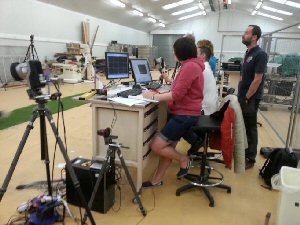 In
April 2015 I was asked to help with organising a range of dogs that were broadly
representative of those currently in the KC’s Large category, to take part in
three days of data collection at the Royal Veterinary College to try and address
these issues. I was also given permission to attend as a very interested
observer and would like to thank the research team and, of course, the dogs and
their handlers for their co-operation in the production of this article. In
April 2015 I was asked to help with organising a range of dogs that were broadly
representative of those currently in the KC’s Large category, to take part in
three days of data collection at the Royal Veterinary College to try and address
these issues. I was also given permission to attend as a very interested
observer and would like to thank the research team and, of course, the dogs and
their handlers for their co-operation in the production of this article.
The dogs taking part illustrated several shapes,
sizes, breeds, ages, grades and heights - all above the KC Medium height of
430mm. They were all passed fit to take part by a veterinary inspection, warmed
up before jumping and given appropriate rest periods.
Design
The experiments were conducted in the Structure and Motion Laboratory at the
Royal Veterinary College, using kinetic (force plate) and kinematic (optional
motion capture) systems to collect data about ground reaction forces when dogs
were in contact with the ground and also whole body/joint kinematics of the dogs
throughout the whole process of jump take-off and landing.
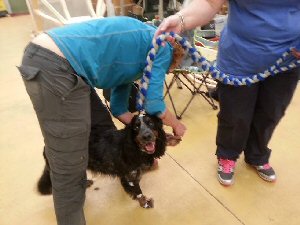 Methodology Methodology
Each dog was vet checked for fitness and weighed. They had their height at
the withers measured and reflective markers applied.
An ingenious measuring
device was used which was manufactured from a spirit level, a builders
electronic tape measure and some sticky tape. It was so quick and fuss free that
the dogs weren’t even aware they were being measured. Weighing them was easy,
too, as they simply stood on one of the force plates.
Their hair was clipped
and the markers were applied with double-sided tape. Anatomical landmarks
included the head (poll), withers, sacrum, tuber coxae (hips), as well as limb
joint centres.
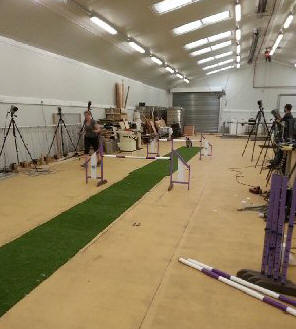 An
array of force platforms were embedded in the ground, covered with an artificial
surface identical to the one used at Crufts. Twelve kinematic cameras were
positioned on either side, to form a jumping lane. An
array of force platforms were embedded in the ground, covered with an artificial
surface identical to the one used at Crufts. Twelve kinematic cameras were
positioned on either side, to form a jumping lane.
Data was collected via
the force plates and kinematic cameras and relayed to computer screens, closely
monitored by the research team. The cameras bounced light off the markers and
picked up the reflections, which were displayed as dots on the computer screens.
There was also some data captured by standard and high speed video.
The researchers aimed to
capture three valid repeats of take-off and landings. Valid jumps were defined
as contacting one or several force plates with all four limbs at take-off and
landing and not knocking down a pole.
Gait Analysis
In addition, the research team made use of a pressure mat system (Gait4Dog)
to collect symmetry data of walk and trot, representing how symmetrical the dogs
provided weight bearing between pairs of limbs as an objective indicator of
soundness.
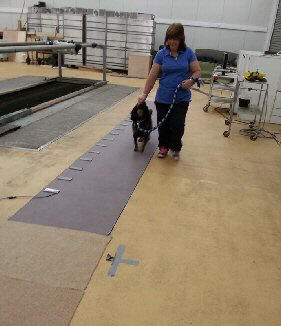 The
Gait4Dog system was able to track each “walk” and “trot” along the mat, and even
each limb - as indicated by a different colour paw print on the screen. The
Gait4Dog system was able to track each “walk” and “trot” along the mat, and even
each limb - as indicated by a different colour paw print on the screen.
It's a good diagnostic tool which would show up an
injury or imbalance. I was very impressed with the hands-on diagnostic skills of
the assessing vet who was able to pin point slight problems in their initial
examination which were also highlighted in the gait analysis.
Proposed Data
Analysis
Data analysis will aim at analysing peak forces (in particular peak vertical
force) exerted onto the ground by front and hind limbs. It will be nearly
impossible to separate the effect of contralateral limbs, since they are both
contacting the ground at the same point, but it will be possible to distinguish
between the force provided by the pair of front limbs and the pair of hind
limbs.
There will also be
further analysis of the relationship between forces and some joint angles.
Markers were placed on joint centres of all the limbs, as well as some upper
body markers to estimate body posture during jumping. Analysis will also examine
how the first jump affects the dog’s performance over the second hurdle.
Personal observations
I
noted on the day I attended the RVC that even the most accomplished, but very small, Grade 7 dog was
required to push herself to the extreme to clear 650mm. Some ordinary slow
motion footage highlighted this extremely well and the hyperextension in her
spine during the landing phase, in particular, was an impressive but possibly
worrying feat (in my opinion).
When you factor in the tight turns, wing wraps,
round the backs of jumps and other manoeuvres that are required in agility
nowadays, then that makes it even more of a concern. It also appeared to me that
her performance at 550mm was markedly more in control than at 650mm.
These are
just a couple of my personal observations, and I am looking forward to seeing
the in-depth results from the scientific data analysis. I really hope this
research provides some insightful information that can be used to help not
only the smaller Large dogs that so many people have been campaigning for but
all dogs in the future.
P.S. You can see
the ingenious dog measuring device on the desk in the bottom centre of the photo
of the research team. Patent pending!
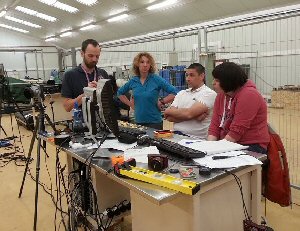 Meet the Research Team Meet the Research Team
Thilo Pfau
is a Senior Lecturer in Bio-Engineering at The Royal Veterinary College.
He is currently focusing on the use of inertial sensor based technology
(as well as traditional kinetics and kinematics) to detect and quantify
movement anomalies, covering a range of tasks and animals.
Lowri Davies
qualified from Bristol Veterinary School in 1992 and spent some years in
Equine Practice working with performance horses. She set up the SMART
(Sports Medicine and Rehabilitation Therapy) Clinic in 2003 and a second
clinic in Cardiff opened four years later. Agility dogs now account for
nearly half their case load. She has lectured internationally on the
subject of rehabilitation and canine sports medicine, as well as
authoring chapters on the subject in several textbooks. She is currently
president of the British Veterinary Sports Medicine and Rehabilitation
Society and sits on the KC’s Activities Health and Welfare Sub-Group.
Gary Doyle
is a senior lecturer in Sports Biomechanics at the University of East
London. His research interests include investigating movement and motion
patterns, with the use of three-dimensional motion capture and force
plate analysis. He has been an agility competitor for over fifteen years
and has judged all grades and sizes. Gary also sits on the Kennel Club’s
Activities Health and Welfare Sub-Group.
Emily
Sparkes has been the Senior
Technician in the Structure and Motion Laboratory at the RVC for the
past four years. Her expertise lies in biomechanics data collection
techniques and movement analysis. Her main research interests are
investigating how to optimise performance and preventing injury. Prior
to her appointment at the RVC, she worked for British Swimming as the
Head Performance Analyst and Biomechanist to the GB Waterpolo squad
through to the London 2012 Olympic Games. In this research project
she is able to use the knowledge she gained from working in elite human
sport, and apply the same ideas and techniques to measure jump
performance in agility dogs.
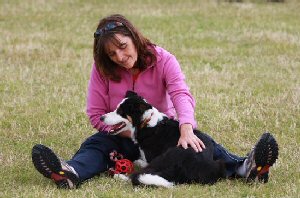 About
the
author... About
the
author...
Chris Garrett has been involved with
agility for 14 years and currently shares her life with two Manchester
Terriers and two Border Collies, competing with them all.
She is
a qualified
agility instructor and lucky enough to have her own equipment and training venue.
She also trains with Dogmanics DAT, a great KC Listed club that offers multiple
height training to many types of dog.
Although some dogs are more naturally
athletic than others, she thinks it is likely that the KC Large height category
might be unfair to, and unsuitable for, many dogs.
|